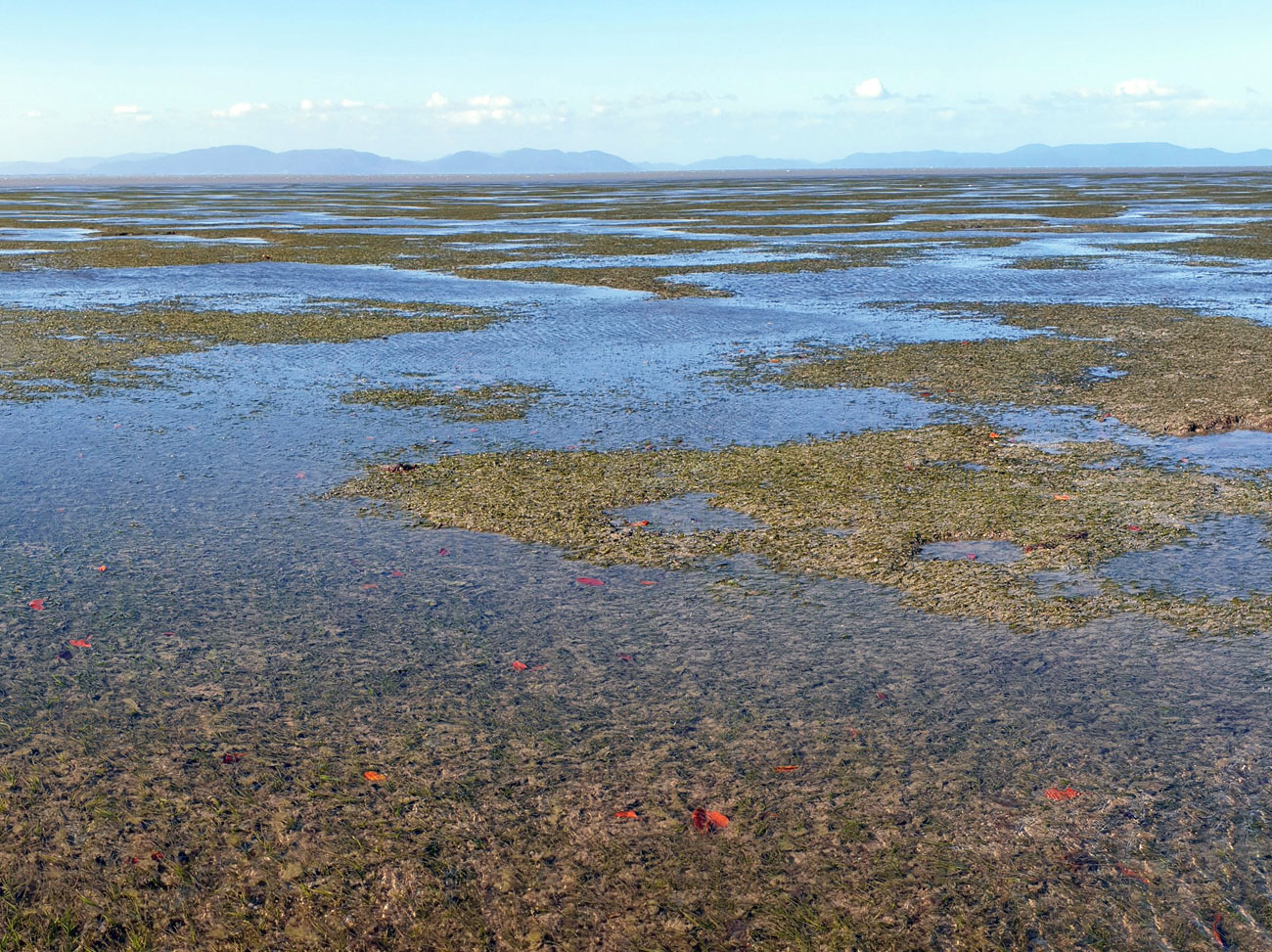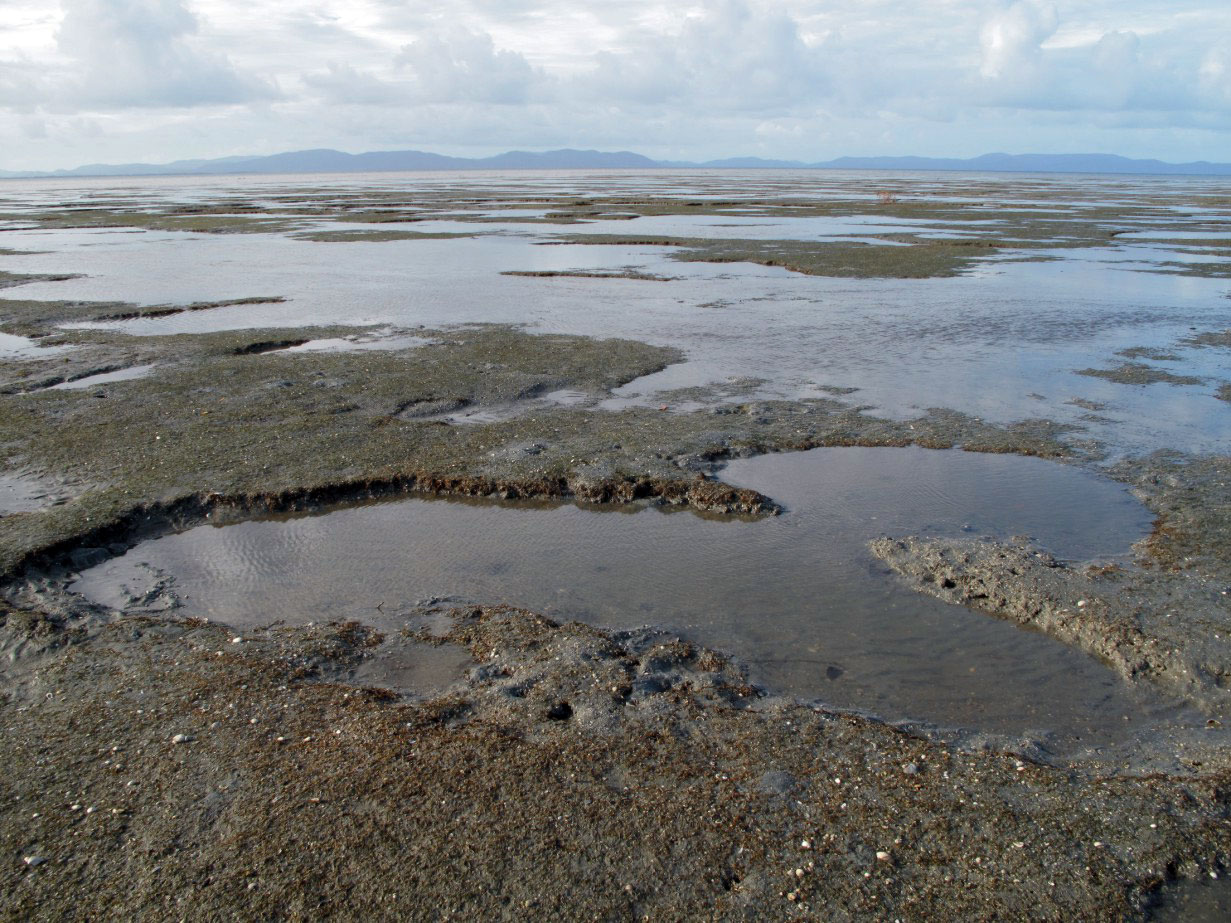pASTURES OF THE OCEAN
The habitat complexity within seagrass meadows enhances the diversity and abundance of animals.
Seagrass provides food and shelter for many organisms, and are a nursery ground for commercially important prawn and fish species. The high primary production rates of seagrasses are closely linked to the high production rates of associated fisheries.
Seagrass supports numerous herbivore- and detritivore-based food chains, and are considered very productive pastures of the sea.
The associated economic values of seagrass meadows are very large, although not always easy to quantify.
- School of Bogue over seagrass (Canary Islands, Spain)
- Photographer: Liam McGuire
FOOD SOURCE
Seagrasses a major food source for a number of grazing animals. The dugong ( Dugongdugon ) and the green turtle ( Cheloniamydas ) mainly feed on seagrass. An adult green turtle eats about two kilograms (wet weight)of seagrass a day, while an adult dugong eats about 28 to 40 kilograms (wet weight) a day.
- Green sea turtle over seagrass (Saint-Pierre, Martinique)
- Photographer: Michele Roux
CARBON SEQUESTER
Globally, seagrasses are as important as forests in storing carbon (on an areal basis) and can store carbon 35 times faster than rainforests.
Coastal seagrass meadows hold up to 83,000 metric tons of carbon km-1
Seagrass meadows occupy less than 0.2% of the world’s oceans, but they are responsible for more than 10% of all carbon in ocean sediments annually.
- Posidonia oceanica
- Photographer: Dimitris Poursanidis
SEDIMENT STABILISTATION
Seagrass, especially structurally large species, acts as a buffer for reducing wave and tidal energy, trapping and stablising sediment with their roots and rhizomes that form dense “mats”. This stabilisation contributes to coastal protection, preventing coastal erosion.
- Seagrass meadow (Midge Point, QLD, Australia)
- Photographer: Len McKenzie


OXYGEN PUMPS
1 meter sq of seagrass can produce up to 10 litres of O2 per day.
Seagrass uses light to convert CO2 + water to sugar + oxygen. It pumps O2 into roots to offset sulphide toxicity and facilitate uptake of nutrients
- Halodule sp (Natadola, Fiji)
- Photographer: Rudi Yoshida
ECOSYSTEM ENGINEERS
Seagrasses are strong ecosystem engineers often improving their physical surroundings. For instance, filtering out nutrients that come from land-based discharge/runoff, preventing algal overgrowth and before these nutrients are washed out further to other sensitive habitats such as coral reefs.
Seagrasses also trap fine sediments and particles that are suspended in the water column, which increases water clarity (allowing for more sunlight to reach seagrass). These all improved conditions allow/help seagrass growth
Without seagrass meadows, sea floor sediments are frequently stirred by wind and waves, decreasing water clarity, affecting marine animal behavior, and generally decreasing the recreational quality of coastal areas.
- Posidonia oceanica
- Photographer: Dimitris Poursanidis
ECOSYSTEM CONNECTIVITY
Tropical seagrasses are important in their interactions with mangroves and coral reefs. All these systems exert a stabilizing effect on the environment, resulting in important physical and biological support for the other communities. 1
Barrier reefs protect coastlines, and the lagoon formed between the reef and the mainland is protected from waves, allowing mangrove and seagrass communities to develop. Seagrasses trap sediment and slow water movement, causing suspended sediment to fall out. This trapping of sediment benefits coral by reducing sediment loads in the water.
Mangroves trap sediment from the land, reducing the chance of seagrasses and corals being smothered. Sediment banks accumulated by seagrasses may eventually form substrate that can be colonized by mangroves.
All three communities trap and hold nutrients from being dispersed and lost into the surrounding oceanic waters
- Mangrove and Seagrass (Cooktown, QLD)
- Photographer: Len McKenzie
BENEFITS TO CORAL REEFS
The incorporation of carbon within seagrass tissues can affect local pH & increase calcification of coral reefs, thereby mitigating the effects of ocean acidification.
Seagrasses also trap fine sediments and particles that are suspended in the water column, which increases water clarity.
Adjacent coral reefs as well as coral patches within seagrass meadows benefit from the improved water quality
Seagrass meadows can reduce disease causing bacterial pathogens by >50%, to the benefit of humans and adjacent coral reefs.
- Corals and Seagrass. (Ovalau Island, Fiji)
- Photographer: Len McKenzie
SEAGRASS GUARDIANS
Sharks, are often misunderstood, often described as man-eaters. But researchers have now discovered that sharks are critical in helping ecosystems recover from extreme climatic events.
Sharks are seagrasses first line of defence from overgrazing by dugongs, sea turtles, and other herbivores. Where sharks rove seagrass meadows, grazers steer clear, encouraging an even spread of grazing. Sharks also mitigate increased herbivore abundances, which keeps seagrasses from being decimated.
Sharks keep a seagrass ecosystem healthy and able to respond to stresses. When seagrass is damaged, sharks assist recovery by reducing herbivory and allowing maintenance of goods and benefits.
When factors such as heat waves/cyclones destroy seagrasses, disrupting marine ecosystems and removing critical stores of “blue carbon,” which help mitigate climate change, sharks become critical for ecosystem health.
- Shark over seagrass
- Photographer: Jett Britnell
TABLET AND MOBILE PAGE
WHY IS SEAGRASS IMPORTANT
pASTURES OF THE OCEAN
The habitat complexity within seagrass meadows enhances the diversity and abundance of animals.
Seagrass provides food and shelter for many organisms, and are a nursery ground for commercially important prawn and fish species. The high primary production rates of seagrasses are closely linked to the high production rates of associated fisheries.
Seagrass supports numerous herbivore- and detritivore-based food chains, and are considered very productive pastures of the sea.
The associated economic values of seagrass meadows are very large, although not always easy to quantify.
- School of Bogue over seagrass (Canary Islands, Spain)
- Photographer: Liam McGuire
FOOD SOURCE
Seagrasses a major food source for a number of grazing animals. The dugong ( Dugongdugon ) and the green turtle ( Cheloniamydas ) mainly feed on seagrass. An adult green turtle eats about two kilograms (wet weight)of seagrass a day while an adult dugong eats about 28 to 40 kilograms (wet weight) a day kilograms a day.
- Green sea turtle over seagrass (Saint-Pierre, Martinique)
- Photographer: Michele Roux
CARBON SEQUESTER
Globally, seagrasses are as important as forests in storing carbon (on an areal basis) and can store carbon 35 times faster than rainforests.
Coastal seagrass meadows hold up to 83,000 metric tons of carbon km-1
Seagrass meadows occupy less than 0.2% of the world’s oceans, but they are responsible for more than 10% of all carbon in ocean sediments annually.
- Posidonia oceanica
- Photographer: Dimitris Poursanidis
SEDIMENT STABILISTATION
Seagrass, especially structurally large species, acts as a buffer for reducing wave and tidal energy, trapping and stablising sediment with their roots and rhizomes that form dense “mats”. This stabilisation contributes to coastal protection, preventing coastal erosion.
- Seagrass meadow (Midge Point, QLD, Australia)
- Photographer: Len McKenzie
OXYGEN PUMPS
1 Msq of seagrass can produce up to 10 litres of O2 per day.
Seagrass uses light to convert CO2 + water to sugar + oxygen. It pumps O2 into roots to offset sulphide toxicity and facilitate uptake of nutrients
- Halodule sp (Natadola, Fiji)
- Photographer: Rudi Yoshida
ECOSYSTEM CONNECTIVITY
Tropical seagrasses are important in their interactions with mangroves and coral reefs. All these systems exert a stabilizing effect on the environment, resulting in important physical and biological support for the other communities. 1
Barrier reefs protect coastlines, and the lagoon formed between the reef and the mainland is protected from waves, allowing mangrove and seagrass communities to develop. Seagrasses trap sediment and slow water movement, causing suspended sediment to fall out. This trapping of sediment benefits coral by reducing sediment loads in the water.
Mangroves trap sediment from the land, reducing the chance of seagrasses and corals being smothered. Sediment banks accumulated by seagrasses may eventually form substrate that can be colonized by mangroves.
All three communities trap and hold nutrients from being dispersed and lost into the surrounding oceanic waters
- Mangrove and Seagrass (Cooktown, QLD)
- Photographer: Len McKenzie
BENEFITS TO CORAL REEFS
The incorporation of carbon within seagrass tissues can affect local pH & increase calcification of coral reefs, thereby mitigating the effects of ocean acidification.
Seagrasses also trap fine sediments and particles that are suspended in the water column, which increases water clarity.
Adjacent coral reefs as well as coral patches within seagrass meadows benefit from the improved water quality
Seagrass meadows can reduce disease causing bacterial pathogens by >50%, to the benefit of humans and adjacent coral reefs.
- Corals and Seagrass. (Ovalau Island, Fiji)
- Photographer: Len McKenzie
SEAGRASS PROTECTORS
Sharks, are often misunderstood, often described as man-eaters. But researchers have now discovered that sharks are critical in helping ecosystems recover from extreme climatic events.
Sharks are seagrasses first line of defence from overgrazing by dugongs, sea turtles, and other herbivores. Where sharks rove seagrass meadows, grazers steer clear, encouraging an even spread of grazing. Sharks also mitigate increased herbivore abundances, which keeps seagrasses from being decimated.
Sharks keep a seagrass ecosystem healthy and able to respond to stresses. When seagrass is damaged, sharks assist recovery by reducing herbivory and allowing maintenance of goods and benefits.
When factors such as heat waves/cyclones destroy seagrasses, disrupting marine ecosystems and removing critical stores of “blue carbon,” which help mitigate climate change, sharks become critical for ecosystem health.
- Shark over seagrass
- Photographer: Jett Britnell